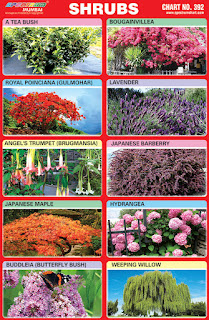 |
| Shrubs Chart |
Spectrum Chart - 392 : Shrubs
1. Tea Bush – Tea is an evergreen plant
that grows mainly in tropical and subtropical climates. A tea plant
will grow into a tree of up to 16 m if left undisturbed, but
cultivated plants are generally pruned to waist height for ease of
plucking. Only the top 1–2 inches of the mature plant are picked. A
plant will grow a new flush every seven to 15 days during the growing
season.
2. Bougainvillea - Bougainvilleas are
popular ornamental plants in most areas with warm climates. It makes
an excellent hot season plant and its drought tolerance makes it
ideal for warm climates year-round. Its high salt tolerance makes it
a natural choice for colour in coastal regions. Bougainvilleas grow
best in dry soil in very bright full sun and with frequent
fertilisation, but they require little water once established and in
fact will not flourish if over-watered.
3. Royal Poinciana (Gulmohar) - Royal
Poinciana is a species of flowering plant in the bean family
Fabaceae, subfamily Caesalpinioideae. It is noted for its fern-like
leaves and flamboyant display of flowers. In many tropical parts of
the world it is grown as an ornamental tree. Royal Poinciana requires
a tropical or near-tropical climate, but can tolerate drought and
salty conditions. It prefers an open, free-draining sandy or loamy
soil enriched with organic matter.
4. Lavender - Lavender is a genus of 39
known species of flowering plants in the mint family, Lamiaceae. It
is native and is found from Cape Verde and the Canary Islands, Europe
across to northern and eastern Africa, the Mediterranean, southwest
Asia to southeast India.
Many members of the genus are
cultivated extensively in temperate climates as ornamental plants for
garden and landscape use, for use as culinary herbs and also
commercially for the extraction of essential oils.
5. Angel's Trumpet (Brugmansia) –
Angel's Trumpet (Brugmansia) are large shrubs or small trees, with
semi-woody, often many-branched trunks. They can reach heights of
3–11 m. The name angel's trumpet refers to the large, pendulous,
trumpet-shaped flowers. They are native to tropical regions of South
America, along the Andes from Venezuela to northern Chile and also in
south-eastern Brazil.
6. Japanese Barberry - Japanese barberry
is a species of Berberis, native to Japan and eastern Asia, though
widely naturalised in China and in North America. It is a dense,
deciduous, spiny shrub which grows 0.6 to 2.5 m high. It has deeply
grooved, brown, spiny branches with a single spine at each shoot
node.
7. Japanese Maple - Japanese maple is a
deciduous shrub or small tree reaching heights of 6 to 10 m, often
growing as an under story plant in shady woodlands. Plant is native to
Japan, China, Korea, eastern Mongolia and southeast Russia. Many
different cultivars of this maple have been selected and they are
grown worldwide for their large variety of attractive forms, leaf
shapes and spectacular colours.
8. Hydrangea – Hydrangea is a genus of
70–75 species of flowering plants native to southern and eastern
Asia (China, Japan, Korea, the Himalayas and Indonesia) and the
Americas. Most are shrubs 1 to 3 meters tall, but some are small
trees.
9. Buddleia (Butterfly Bush) - Buddleia
commonly known as the butterfly bush is a genus comprising over 100
species of flowering plants endemic to Asia, Africa and the Americas.
Of the approximately 100 species nearly all are shrubs less than 5 m
tall, but a few qualify as trees.
10. Weeping Willow - Weeping willow is a
species of willow native to dry areas of northern China, but
cultivated for millennia elsewhere in Asia, being traded along the
Silk Road to southwest Asia and Europe. Weeping willow trees are used
to create many useful items ranging from sports equipment to
medicine.

No comments:
Post a Comment